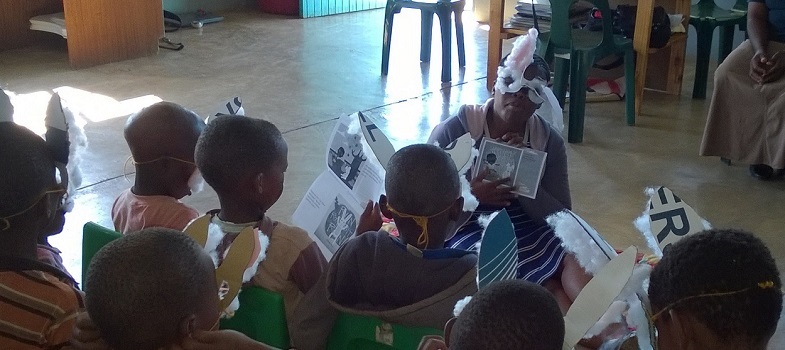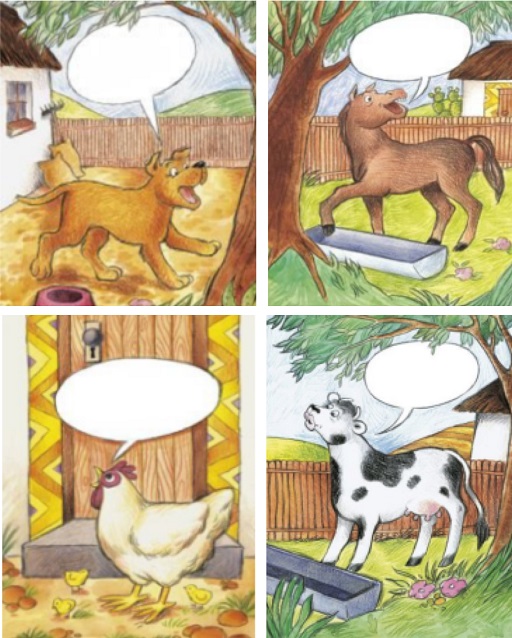Using pictures to support early reading skills
Having selected a storybook you think your children will enjoy, reflect on the decisions you took to make your selection.
Children who are ready to learn to read will begin to explore the relationships between objects, pictures, sounds, letters and written words.
When we are adults, we take for granted how important the combination of words and pictures is to help us make sense of things. We read newspapers with photographs, we see illustrations on signs, we notice images and labels on posters, and we recognise logos on food labels. You may know children in your classes who are able to recognise long before they can decode letters and sounds in books.
A good way to help children grasp the relationship between images and words on a page is through the use of pictures and picture books. Some children will have enjoyed sharing picture books from an early age at home, but others will have had limited access to any books. As their teacher, you need to think of different ways to give every child the opportunity to enjoy the experience of picture books. Pictures are a very important part of telling a story, and for early readers the pictures are useful in helping to remember the sequence of the story and ‘what comes next’.
You may already use pictures in your lessons – drawing three simple pictures on the blackboard, for example, to show the beginning, middle and end of a simple trip to the market. Children are then encouraged to retell the story in simple sentences: ‘I went with my brother to market. We bought maize and coffee beans. Mama was happy.’ This simple starting idea can be extended and made more interesting:
- The children could work in small groups to act out their story, adding details and characters that they meet along the way. Their excitement and enthusiasm for these stories can be greatly increased by adding sounds to the story: footsteps, knocking on a door or speaking in different voices for each character in the story.
- You could also read a local traditional tale aloud and ask the children to draw pictures to match the story as you read. They can then share their pictures with each other, make up their own stories and perform them.
- Create picture cards from a favourite story – you can download pictures and print them out, find pictures in magazines or newspapers, or draw them. A storybook like Look at the Animals [Tip: hold Ctrl and click a link to open it in a new tab. (Hide tip)] has some easy pictures to copy. Hand out the picture cards and ask the children to hold up their picture when you tell their part of the story.
Discuss these ideas with colleagues and choose one to try out in your classroom next week.
Activity 3.5: Using familiar themes to support early reading
Choose a story you know well that features animals, or choose one from ASb. For example, A Little Girl – a storybook that has been translated from isiZulu into English – tells the story of a girl who travels through the forest to visit her grandfather. Along the way, she meets a careless goat that warns her about a meeting of the animals in the forest.
Part 1
Write down in your study notebook the reasons why animals are a good starting point for encouraging early reading development. Compare your answers with the discussion below.
Discussion
Animals are fun because children are already familiar with a variety of animals and the sounds they make, and children enjoy drawing. Many traditional tales feature animals.
Part 2
Choose one of the following picture story themes that you could use with young children: family, food, home, clothing, village, people’s jobs, vehicles, household objects or games.
Now answer the following questions in your study notebook:
- How could you use them in a story?
- What actions or sounds could you add? (Ask the children for their ideas.) Make four picture cards for your chosen theme and make notes of how you could use the cards with your class. Alternatively, you could download examples from the ASb website, such as Look at the Animals.
- Write your own story, which you will read to your children. Write one simple sentence for each of your four picture cards. Add detail about the characters, the setting and the plot.
If you get the chance, try these activities out with your class and note down how the children respond. Talk to a colleague about how the activity went.
Now read Case Study 3.2 and try the activity that follows it.
Case Study 3.2: Salome’s new class
Salome has just finished her diploma training, where she specialised in early childhood education, and she has been posted to a school in northern Ghana. She thinks that there will not be many resources in the classroom, so she takes with her a set of laminated picture cards she made at her college. These pictures can be arranged in different ways to tell stories, especially stories she has learnt from her own grandparents, which she notes down in her notebook.
Salome speaks some Dagbani, one of the 11 official languages in Ghana, though it is not her own first language, so she knows that she will have to translate the stories and games. On her first day in her new school she has a large class of children, and she uses just three or four of the laminated picture cards to teach the children in Dagbani. Her teaching focuses on the vocabulary of local animals and the noises they make. The children really enjoy hearing the noises and Salome encourages them to make the noises along with her.
She goes through the names of the animals again, and the second time, when it gets to the animal noises she waits for the children to see if they can remember the noise and join in. This time she tells the story Look at the Animals and the children join in with the noises. The children have enjoyed the story and they have participated by making the sounds. As she told the story the first time, Salome said the name of each animal. The next time she reads it, she points at the picture of the animal and the children say the animal’s name and make its noise.
Salome also decides on a new activity. She divides the class into small groups of three or four, and each group moves to a different part of the room. She then whispers to each group the name of a (new) animal and gives them a prepared card with the animal name and picture. She gives each group a couple of minutes to decide what noise their animal makes. She has chosen some familiar animals, such as a snake, elephant, cat, monkey, hippo, dog, lion, goat or chicken, and the group makes their noise.
Salome uses the animal words and pictures to retell the story Look at the Animals. She gives groups of children three pictures each so that they can begin to make their own short spoken stories.
She will make time to tell the story again later in the week and hopes the children will be able to remember some of the noises. The following week, when they go through it again, she will ask the children what the noise is for each animal. After that she will put the word for each animal on the board in Dagbani and ask the children to make the noise when she points to the word.
Activity 3.6: Using picture resources
With a colleague, identify what Salome does to support:
- vocabulary development
- picture/text connections
- reading for enjoyment
- home language learning
- participation
- inclusion.
Record your ideas in your study notebook.
Children’s everyday lives as a resource for reading





